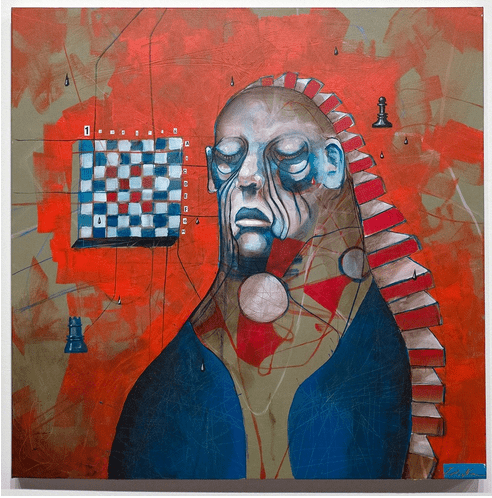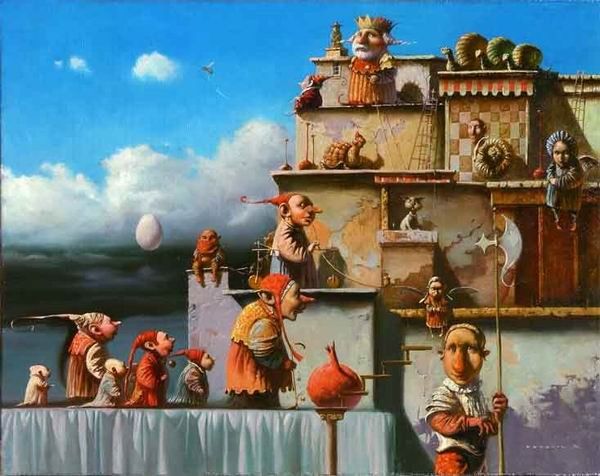
Chess Lyricists vs Chess Physicists
Which One is in the Driver's Seat: Intuition or Calculation?
This post — the first in a three-part series — looks into the workings of the mind of chess player with the central focus on the intuition-calculation duality and how they interact with one another when making decisions at the board.
The insight we are going to obtain will show us how creativity works. It may also indicate some practical ways of how to improve that creativity and our thinking process in general.
The Unconscious
I came across two films recently that gave me the idea to write this post (you can find the at the bottom).
8 x 8: A Chess Sonata in 8 Movements, the American experimental film directed by Hans Richter, Marcel Duchamp, and Jean Cocteau. It is a fairy tale for the subconscious using the medium of chess, part Freud, part Lewis Carroll.
The other is a Soviet film from 1968 directed by Felix Sobolev, 7 Steps Beyond Horizon. It is a popular science film about extraordinary capabilities of human brain starring the legendary Misha Tal in one of the seven stories which is about a blindfold simul he played against ten Candidate Masters.
That was my inspiration for...
Chess art and beauty versus science and logic
All our lives, events, times, are influenced by judgment and decisions we make. We also make micro-decisions throughout the day. At the chessboard too. All this seems to be happening in two realms of body and mind. According to Descartes, everything going on in our minds is by definition conscious. The only function of mind is to produce rational thoughts. All the rest are bodily functions.
However, when we are evaluating position/making decisions at the board, it is clearly not all about analysis and calculation. We know very well that our inner self-teacher, intuition, also affects our judgment. It is that, almost magical ability that give us deep and quick understanding of position without evident rational thought or proof.
This fast apprehension includes two variants of intuitive thought - the expert intuition (recognition of familiar board patterns) and heuristics (a short-cut method to problem solving that uses quick, simplistic solutions to complex problems, using easy ‘rules of thumb’ formulas).
Furthermore, we know very well that perception and memory are also fully automated functions of brain. When we chess players look at the board, we sense (a) the shape and location of pieces (=perception), as well as (b) their type/name (=memory), both without thinking.
So things are much more complex than what Descartes' theory, splitting up the world into realms of matter and rational-only mind, wants us to believe.
Yet it did, what some psychologists call Cartesian catastrophe, create a duality that is deeply rooted in the Western culture.
There is a clash of Unconscious vs Conscious, Intuition vs Calculation, Speculation vs Reason, Feeling vs Proofs, Understanding vs Knowledge, Instinct vs Evidence, Art vs Science, Lyrics vs Physics, Ideas vs Facts, Beauty vs "Truth", System 1 vs System 2...
The System 1 and System 2 are terms introduced by Daniel Kahneman, an American psychologist and economist who was awarded the Nobel prize for his work on the psychology of judgement and decision-making. As per Kahneman, System 1 is fast, effortless and instinctive, while System 2 is slow, deliberate and logical and only gets in when System 1 is unable to make a decision, or there are some conflicting elements at play).
.

Of course, our (un)conscious experiences ('light' and 'dark' events, as Leibnitz called them) do not belong to different compartments of mind; they just form various degrees of awareness. Our experience is, in effect, Fifty (or so) shades of grey.![]()
Important chess questions
The question of lyrics and physics of chess is of extreme importance for us chess players when we consider the following intriguing topics of chess,
- How the thought process of chess player is shaped by this duality of intuition and reason during play,
- How to develop better teaching methods for the beginner in the first critical period of learning so the proper basics (=mindset, the way of thinking!) set in place,
- What methods for improvement of established players may work more effectively and efficiently.
We all know that, even though there is the abundance of sources readily available to everyone (books, DVDs, online courses, etc.) a very small number of players sees improvement despite the large amount of time and effort invested in it. They seemingly hit an invisible wall, stuck and unable to make any further progress (as American GM Andy Soltis explains in What It Takes to Become a Chess Master).
Upcoming posts
In Part 2 we are going to see how the worlds of the conscious and unconscious stack up and how they act together in the creative process in arts and science (you may be surprised to see that new discoveries in sciences come primarily with the aid of, well... intuition).
Part 3 is going to show us how all this works in chess. We will see what the top chess elite and the world champions Magnus Carlsen have to say about it.
Stay tuned.
.
Further reading:
1. The Holy Grail of Chess Improvement
2. Intuition: What Even GMs Don't Get About It. Never Mind NMs
.
Two Films
8 x 8: A Chess Sonata in 8 Movements, the American experimental film directed by Hans Richter, Marcel Duchamp, and Jean Cocteau. It is a fairy tale for the subconscious using the medium of chess, partly Freud, partly Lewis Carroll.
The other is a Soviet film from 1968 directed by Felix Sobolev, 7 Steps Beyond Horizon. It is a popular science film about extraordinary capabilities of human brain starring the legendary Misha Tal in one of the seven stories. (check @Spektrowski Mikhail Tal's blindfold simul documentary)
